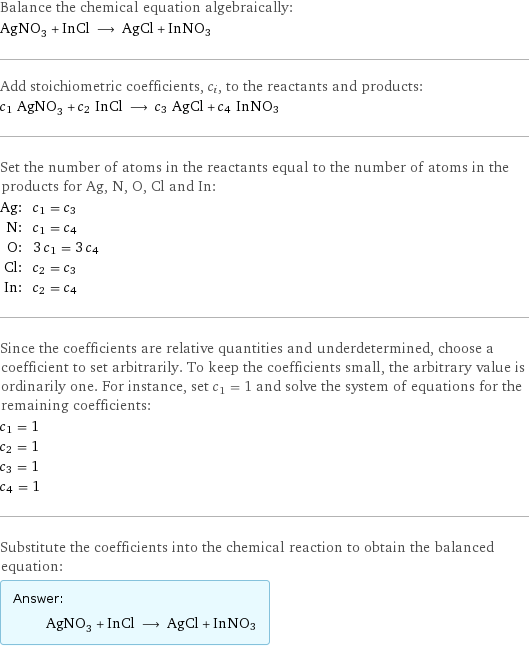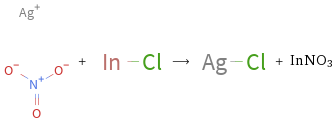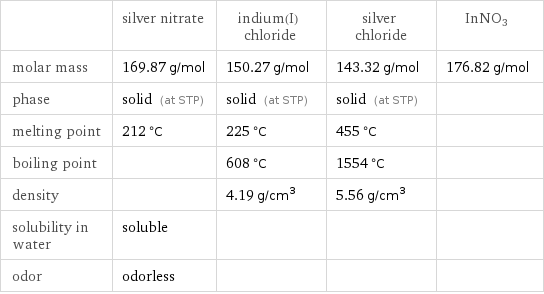Input interpretation

AgNO_3 silver nitrate + InCl indium(I) chloride ⟶ AgCl silver chloride + InNO3
Balanced equation

Balance the chemical equation algebraically: AgNO_3 + InCl ⟶ AgCl + InNO3 Add stoichiometric coefficients, c_i, to the reactants and products: c_1 AgNO_3 + c_2 InCl ⟶ c_3 AgCl + c_4 InNO3 Set the number of atoms in the reactants equal to the number of atoms in the products for Ag, N, O, Cl and In: Ag: | c_1 = c_3 N: | c_1 = c_4 O: | 3 c_1 = 3 c_4 Cl: | c_2 = c_3 In: | c_2 = c_4 Since the coefficients are relative quantities and underdetermined, choose a coefficient to set arbitrarily. To keep the coefficients small, the arbitrary value is ordinarily one. For instance, set c_1 = 1 and solve the system of equations for the remaining coefficients: c_1 = 1 c_2 = 1 c_3 = 1 c_4 = 1 Substitute the coefficients into the chemical reaction to obtain the balanced equation: Answer: | | AgNO_3 + InCl ⟶ AgCl + InNO3
Structures

+ ⟶ + InNO3
Names

silver nitrate + indium(I) chloride ⟶ silver chloride + InNO3
Equilibrium constant
![Construct the equilibrium constant, K, expression for: AgNO_3 + InCl ⟶ AgCl + InNO3 Plan: • Balance the chemical equation. • Determine the stoichiometric numbers. • Assemble the activity expression for each chemical species. • Use the activity expressions to build the equilibrium constant expression. Write the balanced chemical equation: AgNO_3 + InCl ⟶ AgCl + InNO3 Assign stoichiometric numbers, ν_i, using the stoichiometric coefficients, c_i, from the balanced chemical equation in the following manner: ν_i = -c_i for reactants and ν_i = c_i for products: chemical species | c_i | ν_i AgNO_3 | 1 | -1 InCl | 1 | -1 AgCl | 1 | 1 InNO3 | 1 | 1 Assemble the activity expressions accounting for the state of matter and ν_i: chemical species | c_i | ν_i | activity expression AgNO_3 | 1 | -1 | ([AgNO3])^(-1) InCl | 1 | -1 | ([InCl])^(-1) AgCl | 1 | 1 | [AgCl] InNO3 | 1 | 1 | [InNO3] The equilibrium constant symbol in the concentration basis is: K_c Mulitply the activity expressions to arrive at the K_c expression: Answer: | | K_c = ([AgNO3])^(-1) ([InCl])^(-1) [AgCl] [InNO3] = ([AgCl] [InNO3])/([AgNO3] [InCl])](../image_source/fba00dbf04dac632b7bed3f7034dca23.png)
Construct the equilibrium constant, K, expression for: AgNO_3 + InCl ⟶ AgCl + InNO3 Plan: • Balance the chemical equation. • Determine the stoichiometric numbers. • Assemble the activity expression for each chemical species. • Use the activity expressions to build the equilibrium constant expression. Write the balanced chemical equation: AgNO_3 + InCl ⟶ AgCl + InNO3 Assign stoichiometric numbers, ν_i, using the stoichiometric coefficients, c_i, from the balanced chemical equation in the following manner: ν_i = -c_i for reactants and ν_i = c_i for products: chemical species | c_i | ν_i AgNO_3 | 1 | -1 InCl | 1 | -1 AgCl | 1 | 1 InNO3 | 1 | 1 Assemble the activity expressions accounting for the state of matter and ν_i: chemical species | c_i | ν_i | activity expression AgNO_3 | 1 | -1 | ([AgNO3])^(-1) InCl | 1 | -1 | ([InCl])^(-1) AgCl | 1 | 1 | [AgCl] InNO3 | 1 | 1 | [InNO3] The equilibrium constant symbol in the concentration basis is: K_c Mulitply the activity expressions to arrive at the K_c expression: Answer: | | K_c = ([AgNO3])^(-1) ([InCl])^(-1) [AgCl] [InNO3] = ([AgCl] [InNO3])/([AgNO3] [InCl])
Rate of reaction
![Construct the rate of reaction expression for: AgNO_3 + InCl ⟶ AgCl + InNO3 Plan: • Balance the chemical equation. • Determine the stoichiometric numbers. • Assemble the rate term for each chemical species. • Write the rate of reaction expression. Write the balanced chemical equation: AgNO_3 + InCl ⟶ AgCl + InNO3 Assign stoichiometric numbers, ν_i, using the stoichiometric coefficients, c_i, from the balanced chemical equation in the following manner: ν_i = -c_i for reactants and ν_i = c_i for products: chemical species | c_i | ν_i AgNO_3 | 1 | -1 InCl | 1 | -1 AgCl | 1 | 1 InNO3 | 1 | 1 The rate term for each chemical species, B_i, is 1/ν_i(Δ[B_i])/(Δt) where [B_i] is the amount concentration and t is time: chemical species | c_i | ν_i | rate term AgNO_3 | 1 | -1 | -(Δ[AgNO3])/(Δt) InCl | 1 | -1 | -(Δ[InCl])/(Δt) AgCl | 1 | 1 | (Δ[AgCl])/(Δt) InNO3 | 1 | 1 | (Δ[InNO3])/(Δt) (for infinitesimal rate of change, replace Δ with d) Set the rate terms equal to each other to arrive at the rate expression: Answer: | | rate = -(Δ[AgNO3])/(Δt) = -(Δ[InCl])/(Δt) = (Δ[AgCl])/(Δt) = (Δ[InNO3])/(Δt) (assuming constant volume and no accumulation of intermediates or side products)](../image_source/1eee6d1678302781a2e52d4b10f5d1f5.png)
Construct the rate of reaction expression for: AgNO_3 + InCl ⟶ AgCl + InNO3 Plan: • Balance the chemical equation. • Determine the stoichiometric numbers. • Assemble the rate term for each chemical species. • Write the rate of reaction expression. Write the balanced chemical equation: AgNO_3 + InCl ⟶ AgCl + InNO3 Assign stoichiometric numbers, ν_i, using the stoichiometric coefficients, c_i, from the balanced chemical equation in the following manner: ν_i = -c_i for reactants and ν_i = c_i for products: chemical species | c_i | ν_i AgNO_3 | 1 | -1 InCl | 1 | -1 AgCl | 1 | 1 InNO3 | 1 | 1 The rate term for each chemical species, B_i, is 1/ν_i(Δ[B_i])/(Δt) where [B_i] is the amount concentration and t is time: chemical species | c_i | ν_i | rate term AgNO_3 | 1 | -1 | -(Δ[AgNO3])/(Δt) InCl | 1 | -1 | -(Δ[InCl])/(Δt) AgCl | 1 | 1 | (Δ[AgCl])/(Δt) InNO3 | 1 | 1 | (Δ[InNO3])/(Δt) (for infinitesimal rate of change, replace Δ with d) Set the rate terms equal to each other to arrive at the rate expression: Answer: | | rate = -(Δ[AgNO3])/(Δt) = -(Δ[InCl])/(Δt) = (Δ[AgCl])/(Δt) = (Δ[InNO3])/(Δt) (assuming constant volume and no accumulation of intermediates or side products)
Chemical names and formulas

| silver nitrate | indium(I) chloride | silver chloride | InNO3 formula | AgNO_3 | InCl | AgCl | InNO3 Hill formula | AgNO_3 | ClIn | AgCl | InNO3 name | silver nitrate | indium(I) chloride | silver chloride | IUPAC name | silver nitrate | chloroindium | chlorosilver |
Substance properties

| silver nitrate | indium(I) chloride | silver chloride | InNO3 molar mass | 169.87 g/mol | 150.27 g/mol | 143.32 g/mol | 176.82 g/mol phase | solid (at STP) | solid (at STP) | solid (at STP) | melting point | 212 °C | 225 °C | 455 °C | boiling point | | 608 °C | 1554 °C | density | | 4.19 g/cm^3 | 5.56 g/cm^3 | solubility in water | soluble | | | odor | odorless | | |
Units
